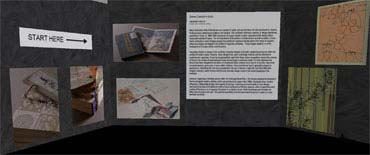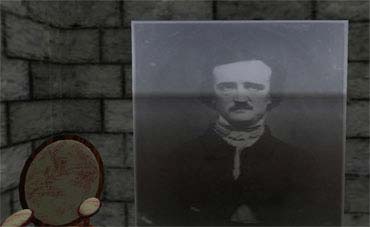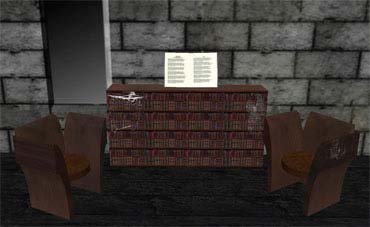Second Life: Engaging Virtual Campuses
In the previous article in this series, Real-Life Teaching in a Virtual World, we looked at the state of Second Life as it pertains to higher education. There are so many schools represented that one could spend days exploring the college and university campuses. The ways they are used in the 3D online virtual world vary drastically, and how much and how well they are used appear to vary as well.
First, the bad: ghost towns abound. Just as many corporations have created presences in Second Life with the approach of "if you build it, they will come," some colleges and universities have done the same. One can go from one campus to the next and find empty campuses, no visitors, no representatives. Making it worse is that, despite the wealth of presentation tools provided in Second Life, one can visit some campuses and leave without a clue if they are actually using their presence in Second Life and, if so, how. With no contact name provided, asking questions is ... well ... out of the question. A visitor is likely to exit quickly, likely with a less-than-favorable impression of the institution.
In contrast, a number of campuses have clear and immediately accessible signage and marketing materials that tell the story. They explain that the build is a replica of their campuses and is used for information dissemination and recruiting and to show off the aesthetics of the buildings. On other campuses, you can actually see student projects, with signage describing the goals and uses.
The University of Delaware uses one of the easiest and most effective tools in Second Life to tell the story of their campus--an automated tour. Visitors who opt to take the tour are taken on a 5-and-a-half-minute virtual fly-over of the campus. As the tour arrives at key areas, text appears on the screen explaining the section and how it is used. During this quick tour, one learns that they have a number of classrooms in varying sizes, from small areas that seat a dozen or so people to an outdoor classroom that seats 60. There are video and PowerPoint screens available for instructors and presenters, areas for students to build projects, and sections where faculty can meet. The University of Delaware also has an observatory that, according to the tour, will feature a working telescope for viewing the latest astronomy discoveries. The university even pays homage to Delaware's role in World War II with a replica of a lookout tower.
The build at Stanford University Libraries boasts about important collections. At the landing point, there are signs explaining current exhibits, and clickable ways to transport directly to those exhibits. One section has highlights from the Stanford Libraries Rare Books Collection. Again, clickable signage explains the collections. In another section, Stanford built a demonstration of a virtual archive. This exhibit explains the benefits of a virtual archive--people can browse non-circulating archival materials, even paging through documents that, outside of a virtual worlds such as Second Life, would not be possible.

Stanford University Libraries is also running an exhibit of Kimono Zuancho (design idea books) that Stanford began collecting in 2004. These are woodblock-produced books from Kyoto, Japan, ca. 1890-1940. The exhibit in Second Life is filled with photos of the items along with signs explaining each one.
Montclair State University of Upper Montclair, NJ, uses its Second Life build in a number of ways. A.J. Kelton is the director of emerging instructional technology for the College of Humanities and Social Sciences and Second Life project coordinator for College of Education and Human Services. According to Kelton, Montclair's Second Life projects began in April 2007 and have expanded greatly since.
"MSU has quite an impressive spread of islands here," he said. "There are some amazing faculty projects going on, and the faculty involved is so talented."
Some MSU efforts are designed to bring literature to life. The Edgar Allan Poe exhibit is a virtual house based on the house in the short story "The Fall of the House of Usher." Inside, visitors can read the text of several of Poe's works. The house serves as a classroom, too, for a professor teaching English at Lehigh Carbon Community College in Pennsylvania. Another build brings the imagery of Gloria Naylor's novel "Mama Day" into Second Life. Another, built by students, has a theme based on Margaret Atwood's "The Handmaid's Tale." A current project at the Montclair State build is Quidditch Stadium, being built by a faculty member teaching "Harry Potter" books.

Another upcoming project is quite large, and, again, students will build it for a class project. The Theorist Project will display areas dedicated to Adler, Frankl, Freud, Gestault, Jung, Maslow, and Rogers. Kelton said this will be an excellent demonstration of how to use virtual environments to teach difficult concepts, and engage students in the process.
Also a class project is the Iraq War Memorial situated on the virtual campus of the University of North Carolina at Chapel Hill. Two students used it as their final project for a class called Human Information Interaction. The build includes U.S. state flags. By touching the base of the states' flags, visitors are given note cards with detailed lists of the names, ranks and dates of the fallen soldiers, arranged in alphabetical order by city.
In the next article in this series, we'll examine teachers and institutions making extensive use of Second Life as part of their curricula.